
Morgan Stanley: Peak Car—or Just Bumps in the Road?
The auto industry is critically important for the global economy, but it has seen a disruptive slide: global registrations, demand and production have slumped.
07.11.2019 | 07:50 Uhr
The decline in passenger car demand seems to be persistent and independent of trade tariffs. Rather, it seems to be driven primarily by tighter emissions standards and government initiatives aimed at encouraging a shift towards electric vehicles (EVs). The economic implications are likely to follow a U-shaped pattern, with a destructive decline followed by investment-driven growth.
Autos: Critical to manufacturing and employment
Any slowdown in the industry is likely to have significant global economic ramifications. Automobiles are a key part of the manufacturing sector in a number of countries (Display 1). In 2017, the global industry directly employed roughly eight million people, and indirect employment (think automobile components) is estimated to be between 4.3x (U.S.) and 6.2x (Japan) that of direct employment.1 And indirect employment does not take into account second-order effects, such as the positive influence on towns built around car factories.
DISPLAY 1: A global industry
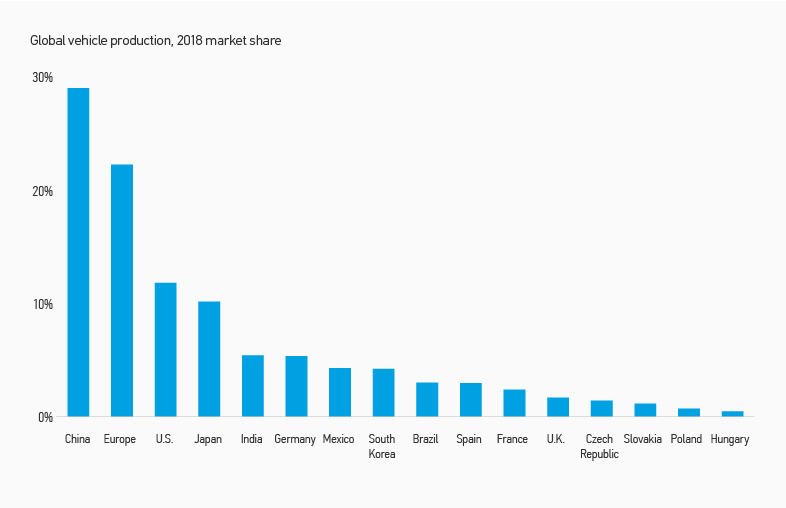
Source: OICA, Datastream, data as of 31 December 2018
On the skids: Global car demand
China, which makes up almost 30% of global passenger car demand, saw vehicle registrations contract by over 4% year-over-year (YoY) in 2018, the first decline since the 1990s.2 Through June 2019, registrations fell further and were down 12.9% YoY (Display 2). This is meaningful—none of the growth shocks China has faced over the past decade resulted in a contraction in sales. A combination of cyclical and structural factors likely contributed to the growth deceleration and we do not expect a pronounced rebound in sales over the next 6-12 months. Given the weakening Chinese economic growth, elevated uncertainty and softening employment growth, it is not surprising that fewer consumers are purchasing a new car. The EU, which employs nearly 14 million people in the auto sector,1 felt a similar drop. After China, the EU is the second largest auto manufacturer, within which Germany is the largest producer and most exposed.
DISPLAY 2: Caution—steep descent in demand
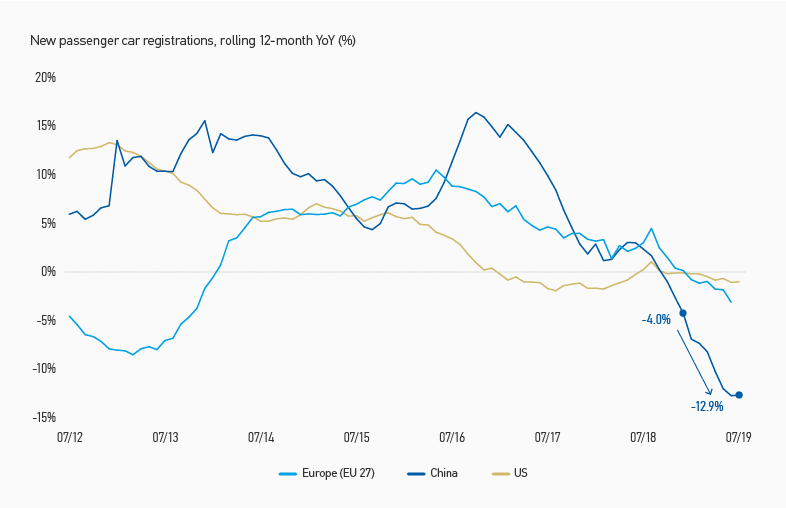
Source: Bloomberg, data as of 30 July 2019
Global passenger car production has mirrored the drop in registrations, falling 3.2% in 2018—the first contraction since the financial crisis (of 2008).3 This is especially striking in China and Germany, where production is down 15% YoY in both economies (Display 3). Both domestic demand and exports are suffering, and the trend does not appear to be linked to a recession or the trade war. In China, for example, 90% of automobile production is domestic.4
DISPLAY 3: Car production is also falling
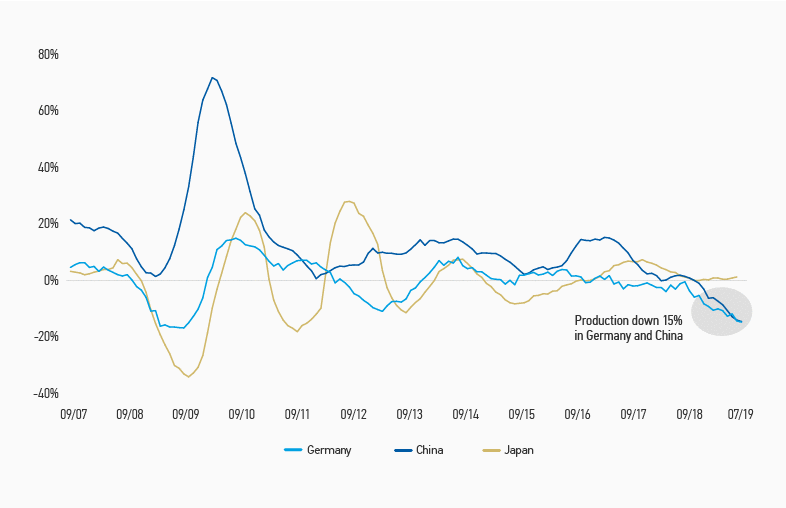
Source: Verband der Automobilindustrie, Japan Auto Dealers/Manufacturers Association/Haver Analytics, CAAM
n some countries—particularly the U.S., and to a lesser extent China and India—this trend can be partially explained by a “bigger is better” preference for SUVs and light trucks, which are not included in global car data. When looking at all vehicles, including SUVs and light trucks, the data is not quite as stark, but it clearly reflects an overall deceleration in the vehicle market.
Notably, the decline in sales does not apply to battery electric vehicles, which have been growing albeit from a very low base. Japan has been able to dodge the trend towards declining production (Display 3), as they have been one of the countries most focused on hybrids and energy efficient vehicles.
Applying the brakes: Global emissions standards
Much of this global decline seems to be driven by increasingly strict governmental policies regulating the internal combustion engine (ICE). In fact, various regions have tightened emissions standards where they essentially mandate the sale of electric vehicles. Manufacturers are at a point where it is no longer possible to further improve mileage efficiencies or reduce vehicle weights. Therefore, the only solution is to pivot to EVs.
The EU, for example, has set targets to cut passenger car CO2 emissions from 130g/km to 95g/km by 2030. If an auto manufacturer’s fleet has average CO2 emissions exceeding its yearly target, for each car registered they are fined €95 per g/km of excess emissions.5 Even the most efficient ICE fleets will not meet these new standards without a 30%-40% penetration of zero-emission EVs among new car sales.6
Some countries have gone as far as instituting 100% zero-emission vehicle targets.7 Norway has been the most aggressive with a planned ban on ICE-sales by 2025, and six countries8 are expected to follow suit by 2030. Eleven countries have endorsed the EV30@30 campaign, 9 which targets a collective 30% market share for electric vehicles by 2030.10
Accordingly, all the major car manufacturers now have clear commitments towards EVs. But debilitating up-front costs have been damaging to the industry. Also hampering the move towards EVs are their profit margins, which are about half those that run on petrol.
Racing ahead: China’s automobile policies
The move towards EV manufacturing has been a stated strategic goal for China since 2009—a reminder that China is a very long-term thinker—and it is both the biggest EV manufacturer and consumer in the world today (Display 4).
DISPLAY 4: China leads in both production and sales of electric vehicles
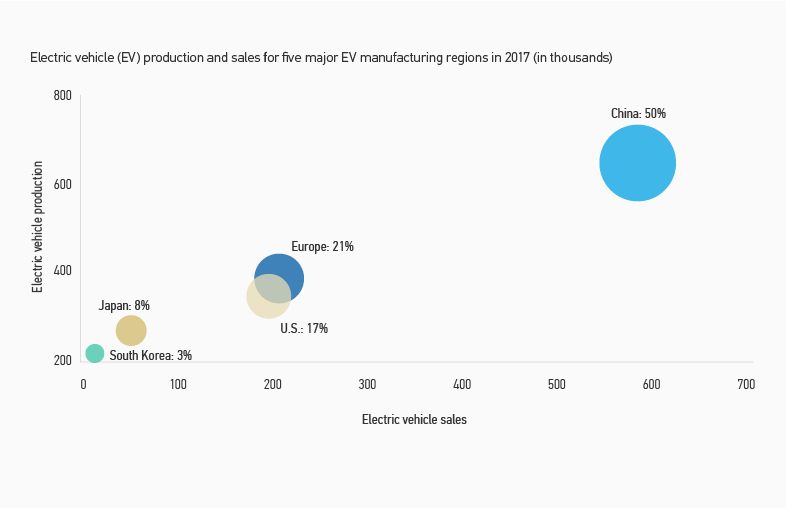
Source: Nic Lutsey, Mikhail Grant, Sandra Wappelhorst, Huan Zhou. “Power Play: How Governments Are Spurring the Electric Vehicle Industry.” International Council on Clean Transportation, May 2018, https://theicct.org/sites/default/files/publications/EV_Government_WhitePaper_20180514. pdf. Europe electric vehicles sales in 2017 are estimated by aggregating sales in Germany, France, U.K., Norway and the Netherlands. Circle sizes are proportional to the percentage of global electric vehicle production.
This July, six cities and nine provinces— accounting for 60% of Chinese car sales— moved from stage 5 emission standards to stage 6, a year ahead of schedule.11 They did so in order to conform to the central government’s desire to combat smog. The acceleration of target dates meant that auto suppliers were absolutely unprepared. In May 2019, only 21% of cars in China met the stage 6 standards, and consumers began to steer clear of stage 5 cars out of concern that they would have no resale value. The resulting disruption contributed to China’s drop in demand. While the worst is likely over, we don’t expect a rebound this year.
Meanwhile, other parts of China will be adopting new standards in July 2020. Sales should start to pick up over time, but it will take years for consumers and manufacturers to adjust to new emissions standards (Display 5).
DISPLAY 5: Steady climb
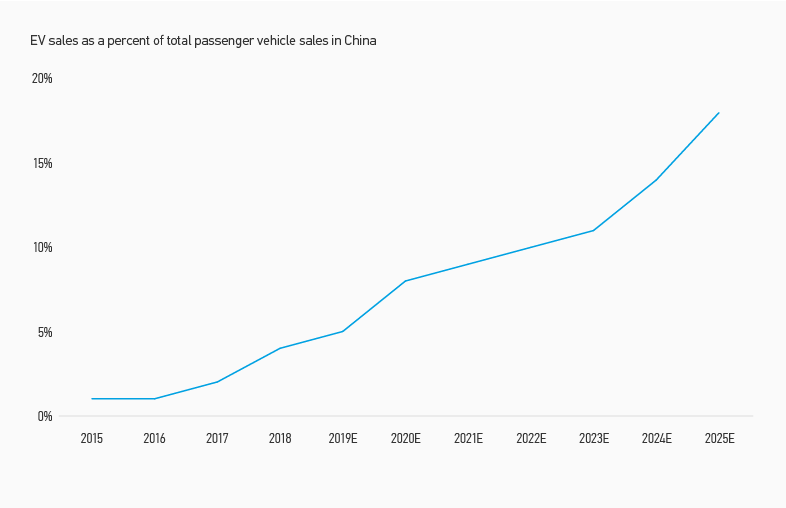
Source: CAAM, Morgan Stanley Research (estimates). Forecasts/estimates are based on current market conditions, subject to change, and may not necessarily come to pass.
Stuck in neutral: The consumer quandary
Meaningful consumer interest in EVs has also been slow to develop. Policies and taxes are directing consumers away from traditional cars, yet EVs are not yet fully viable alternatives. Prices are not yet competitive and supply and variety are quite limited. While the driving range of EVs is increasing rapidly, charging infrastructure is limited and the length of time needed to recharge an EV battery is problematic for longer trips. With uncertainty around such big-ticket purchases, consumers may find it easier to defer their buying decisions.
In the longer-term, we expect demand to pick up. Disruptive trends like car sharing have made car ownership somewhat less important, but they have not yet upset the norms around car ownership. In the U.S., for example, Generation Z still wants to own a car. Germany may be an exception: While the population of Germans between 17 and 25 decreased by 7.5% between 2007 and 2018, the corresponding drop in licenses was roughly 26%.12
Path forward will be a slow U-turn
As the auto industry slogs through disruptive terrain, the economic implications are likely to follow a U-shaped pattern: The industry’s rough downhill road over the past 18 months will eventually evolve into an upward growth trajectory.
In our view, necessary investments in infrastructure and production facilities will eventually fuel significant economic growth. The cumulative investment required to meet the EV-charging infrastructure needs in the three largest car markets—the U.S., the EU and China—is estimated at $50 billion.13 In the EU, for example, there are only about 150,000 public charging points for electric cars; at least 2.8 million will be needed by 2030.14 That translates into a 20-fold increase within the next 12 years.
The employment repercussions are a different story. EV manufacturing tends to be automated, requiring significantly fewer workers and the assembly-line skills needed for building ICE cars are not readily transferable to producing EVs. Auto manufacturers are likely to adapt, but it is smaller companies and employees in the ICE vehicle supply chain which will suffer, given EVs require less parts. Longer term, economic growth will result in employment growth, but the magnitude of employment growth is unclear.
Given how focused it is on ICE vehicles, Germany appears most exposed to the transition to EVs and the government is well aware of the risk of a slowdown. However, any fiscal stimulus from Germany is likely to be re-active rather than proactive due to growth and political hurdles. Growth outlook actually needs to deteriorate more before policymakers will act as there are major constitutional hurdles to issuing debt beyond the current limits imposed by the constitution and their current political commitments. That said, Germany doesn’t even need to raise debt for stimulus. Their budget surplus as at December 2018 was 1.7% of GDP.
Regional road map
Looking at the global regions, we see near-term challenges:
- CHINA: With tentative attempts to re-stimulate their auto industry, China is likely to stabilise somewhat, but not enough to see a significant near-term recovery.
- EUROPE: European performance depends on Germany, but despite a budget surplus and growing concerns, they do not appear in a rush to stimulate until growth deteriorates further. Combined with Brexit acting as a backup brake, Europe seems unlikely to see a broad-based recovery in sales and production in the near term.
- U.S.: We have not seen any tangible plans related to the auto industry, though there is some potential as we get closer to the 2020 election.
- JAPAN: As one of the leaders in hybrids and energy-efficient vehicles, Japan’s auto industry faces the fewest near-term challenges.
Stay off the highway, for now
The auto industry is going through a disruptive pivot. Despite hurdles, countries aiming for zero emissions by 2025 will require significant investments quite soon that should have a stimulative effect. We expect to start seeing these investments—and their effects—kick in within the next two years. The trip to the growth side of the U is still beyond the reach of a single battery charge. In the short run—and until prices drop further—we would caution against investing in the auto industry.
1. Auto industry employment figures sourced for countries and regions as follows: U.S. – Bureau of Labor Statistics, EU – European Automobile Manufacturers Association, Japan – Japan Automobile Manufacturers Association.
2. International Organization for Vehicle Manufacturers, OICA, Datastream, data as of 31 December 2018.
3. International Organization for Vehicle Manufacturers (OICA).
4. 2018 data, calculation based on data from the following sources Global Trade Atlas, Ministry of Industry and Information Technology, China Association of Automobile Manufacturers in www.export.gov/article?id=China-Automotive- Components-Market.
5. European Commission. Accessed 27 September 2019. https: //ec.europa.eu/clima/policies/ transport/vehicles/cars_en
6. Morgan Stanley Research.
7. Global EV Outlook 2019. Denmark, Iceland, Ireland, Israel, Netherlands and Slovenia are all targeting a ban on ICE vehicle sales or 100% zero-emissions vehicle sales.
8. Denmark, Iceland, Ireland, Israel, the Netherlands and Slovenia.
9. Canada, China, Finland, France, India, Japan, Mexico, Netherlands, Norway, Sweden and the United Kingdom.
10. Global EV Outlook 2019.
11. Sun, Yilei and Shirouzu, Norihiko. “Behind the plunge in China auto sales: chaotic implementation of new emission rules.” Reuters, 1 July 2019, https://uk.reuters.com/article/uk-china-autos-insight/behind-the-plunge-in-china-auto-sales-chaotic-implementation-of-new-emission-rules-idUKKCN1TW38N. The cities are Tianjin, Shanghai, Hangzhou, Nanjing, Chengdu, and Chongqing; and the provinces are Hebei, Shandong, Shanxi, Shaanxi, Henan, Anhui, Hainan, Guangdong and Sichuan.
12. Germany’s Motor Transport Authority
13. McKinsey & Company. McKinsey Center for Future Mobility. Charging ahead: electric-vehicle infrastructure demand. October 2018.
14. European Automobile Manufacturers Association (ACEA), press release, 5 April 2019. Car CO2 emissions up: auto makers urge investment in charging infrastructure to boost electric cars.
Risk Considerations
There is no assurance that the strategy will achieve its investment objective. Portfolios are subject to market risk, which is the possibility that the market values of securities owned by the portfolio will decline and that the value of portfolio shares may therefore be less than what you paid for them. Accordingly, you can lose money investing in this portfolio. Please be aware that this strategy may be subject to certain additional risks. There is the risk that the Adviser’s asset allocation methodology and assumptions regarding the Underlying Portfolios may be incorrect in light of actual market conditions and the portfolio may not achieve its investment objective. Share prices also tend to be volatile and there is a significant possibility of loss. The portfolio’s investments in commodity-linked notes involve substantial risks, including risk of loss of a significant portion of their principal value. In addition to commodity risk, they may be subject to additional special risks, such as risk of loss of interest and principal, lack of secondary market and risk of greater volatility, that do not affect traditional equity and debt securities. Currency fluctuations could erase investment gains or add to investment losses. Fixed-income securities are subject to the ability of an issuer to make timely principal and interest payments (credit risk), changes in interest rates (interest rate risk), the creditworthiness of the issuer and general market liquidity (market risk). In a rising interest rate environment, bond prices may fall. In general, equities securities’ values also fluctuate in response to activities specific to a company. Investments in foreign markets entail special risks, such as currency, political, economic and market risks. Stocks of small-capitalisation companies carry special risks, such as limited product lines, markets and financial resources, and greater market volatility than securities of larger, more established companies. The risks of investing in emerging market countries are greater than risks associated with investments in foreign developed markets. Exchange traded funds (ETFs) shares have many of the same risks as direct investments in common stocks or bonds and their market value will fluctuate as the value of the underlying index does. By investing in exchange traded funds ETFs and other Investment Funds, the portfolio absorbs both its own expenses and those of the ETFs and Investment Funds it invests in. Supply and demand for ETFs and Investment Funds may not be correlated to that of the underlying securities. Derivative instruments can be illiquid, may disproportionately increase losses and may have a potentially large negative impact on the portfolio’s performance. The use of leverage may increase volatility in the Portfolio. Diversification does not protect you against a loss in a particular market; however, it allows you to spread that risk across various asset classes.
Here you can find the complete Article.




Diesen Beitrag teilen: